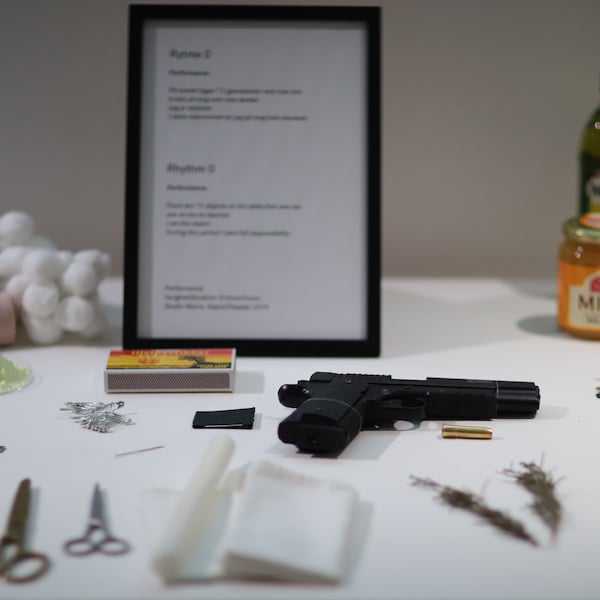View this post on Instagram
In the 1950s, Pop Art made its debut in Post-War Britain and America. While several different artists are responsible for the movement's success, no figure played a bigger role in Pop Art's popularity than Andy Warhol.
While Warhol worked in a myriad of mediums, he is most famous for his polychromatic silk screen prints and paintings. In the 1960s, he began creating pieces that would eventually define many of the movement's most distinctive characteristics: bold, contemporary imagery; a bright color palette; and a repetitive aesthetic inspired by mass production.
Though his work often speaks for itself, it is worth learning more about the figure behind the art. In addition to giving us a glimpse into the mind of the eccentric artist, it can help us understand the significance of his impact—both on Pop Art and art history as a whole.
Learn all about Pop Art's most famous figure with these six Andy Warhol facts.
Childhood illness allowed him to hone his craft at a young age.
View this post on Instagram
Andy Warhol was born on August 6, 1928, in Pittsburgh, Pennsylvania. When he was a young child, he developed Sydenham's chorea, a disorder that resulted in neurological symptoms and blotchy skin. When dealing with the worst of this condition, he would be bed-bound, giving him ample time to draw. These stints, however, were not just crucial to the development of his artistic skills; they also fueled his future interest in popular culture, as it was during his time confined to bed that he began listening to the radio in earnest and filling his walls with magazine clippings and photographs of celebrities.
He started out as a successful shoe illustrator.
View this post on Instagram
As Warhol got older, the drawing style that he had cultivated as a child translated well as commercial illustration. After obtaining a degree in pictorial design from the Carnegie Institute of Technology and moving to New York City in 1949, he was commissioned by Glamour Magazine to illustrate shoes for advertisements. By the early 50s, his fanciful footwear illustrations caught the eye of Israel Miller, a Manhattan-based shoemaker, who asked Warhol to work for him as a shoe designer.
Much more than a means of income, Warhol's work with shoes shaped his personal projects and, subsequently, his success. “Shoes played a prominent role in Warhol’s early career as a commercial artist,” the Tate explains. “His 1950s adverts for women’s footwear were well recognized and his fetish for shoes and feet continued throughout his life.”
Many of his most famous pieces made their debut at his first New York solo show.
View this post on Instagram
Warhol's shoe drawings weren't just popular with designers; they also impressed members of New York City's contemporary art scene, culminating in some of the artist's earliest gallery shows. While shoe illustrations made up the bulk of his exhibited work in the 1950s, his first solo show in 1962 revealed a much larger oeuvre.
Set in Stable Gallery and taking place from November 6 through 24, this show featured some of Warhol's most iconic pieces, like Marilyn Diptych, 100 Soup Cans, and Green Coca Cola Bottles. Aside from 100 Soup Cans, which was painted and stamped by hand, these pieces were crafted using a mix of applied acrylic paint and the silkscreen method. Pioneered by Warhol, this mechanical process allowed the artist to translate photographs—namely, of popular celebrities and everyday objects—as multiple paintings and, in turn, create his own brand of “mass produced” art.
“The reason I'm painting this way is that I want to be a machine,” Warhol said in 1963, “and I feel that whatever I do and do machine-like is what I want to do.”
His New York studio was known as “The Factory.”
View this post on Instagram
Warhol's fascination with consumer culture was evident in his entire artistic process—even his studio. Though his workspace changed locations several times between 1962 and 1984, each one was known affectionately as The Factory. Here, Warhol worked with an assembly line-like team of assistants—an approach he developed in the late 1950s.
The Guggenheim explains: “During these early years, Warhol laid the foundation for his practice of delegating stages of artistic production to assistants, and frequently threw ‘coloring parties,' gatherings during which friends and associates assisted in hand-coloring his numerous works.” At The Factory, he continued this method of production. In addition to artists, however, his collaborators included New York City socialites, Hollywood celebrities, and other famous figures.
A radical feminist writer shot and seriously injured him in 1968.
View this post on Instagram
While most people who visited The Factory were friends of Warhol's, one infamously turned out to be an enemy. Valerie Solanas, a radical feminist author with schizophrenia, met Warhol in the 1960s. After featuring in one of his experimental underground films, she accused the artist of stealing her manuscript for SCUM Manifesto, a self-published book she had written that called for the extinction of men.
On June 3, 1968, she showed up at The Factory, where she shot Warhol and Mario Amaya, a curator and critic. While Amaya's injuries were minor, Warhol's were nearly fatal; two bullets pierced his stomach, liver, spleen, esophagus, and lungs. His injuries called for him to wear a surgical corset for the remainder of his life, and resulted in a phobia of hospitals. Because of his fears, he avoided medical establishments at all costs—even when, in the 1980s, he needed gallbladder surgery. After procrastinating for several years, he finally had the operation in 1987, but, unfortunately, by this point it was too late. He died of cardiac arrest shortly after the procedure.
He managed a band, established a magazine, and co-founded a university—all while making art.
View this post on Instagram
While Warhol is mostly known for his silkscreen paintings, his legacy embodies much more than these experimental pieces. In fact, in addition to creating fine artworks like drawings, prints, and sculptures, including his famous Brillo Box, he also adopted a range of other creative projects. In the 1960s, he managed and produced the rock band The Velvet Underground, culminating in one of his most iconic motifs: a banana for their first album The Velvet Underground & Nico. In 1969, he and Gerard Malang, a prominent art world figure, founded Interview magazine, which remains in circulation today. And, in 1979, he co-founded the New York Academy of Art with other “artists, scholars and patrons of the arts.”
Together with his artistic creations, these contributions have shaped a legacy that has made Warhol one of the 20th century's most important artists—and an inevitable inspiration for artists to come.
Related Articles:
Andy Warhol Socks Cover Your Feet in Iconic Prints by the Pop Artist
Andy Warhol’s Iconic Polaroid Portraits Will Have Their Own Exhibit in London






















































































